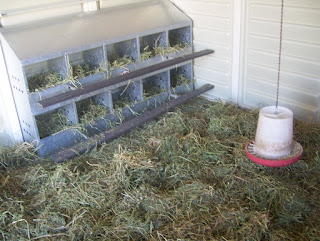I have been learning about modern monoculture--single-crop agriculture--in both the media and in college courses for a half a dozen years now. Modern farming has only been around for about 50 years, and it's made a tremendous impact on global eating habits and economics; repercussions of these changes have been both desirable and disagreeable. While we can get food from all around the world in our local grocery store with nary a second thought, the price for such luxury can be steep. Sometimes even the more "local" produce comes with a burden...as the recent Iowa snafu has brought to the fore.
 |
| Rhode Island Reds |
 |
| Pearl White Leghorns |
A chicken has a few things that it enjoys; she enjoys bathing in the sun, scratching for bugs in the dirt and grass, eating a variety of flowers and grasses fresh from the warm earth, dust-bathing, privacy when she lays, and a safe place to sleep. Sometimes, when we have too many roosters, they harass the ladies and pull out lots of feathers, so occasionally, until we catch them all, the hens look a little...bare. Our hens have access to fresh, self-refilling water bowls, so they never run out. They get pellets with lots of added calcium designed to support the needs of laying hens. They also get grain and fresh hay every day, along with whatever they scratch up themselves out in the yard. They have a spacious coop to lay and sleep in, with 10 individual nest boxes. Perhaps most importantly of all, they get plenty of fresh air and sunlight every day...as soon as the sun is up, so are they. Also, my kids love on the hens they can catch, and we give them out leftover veggies and pasta from mealtimes.
 |
| Some of Our Chickens |
Now, many home farms that have chickens, or people that just have a couple of layers, have chickens that lead very similar lives. These chickens are lucky...at least compared to the "Battery Hen." Many of these hens never see the light of day. They have no where to scratch and no where to hide when they lay. Even "cage-free" layers are often raised in barns, without access to the outside. These birds are often stressed out, and stressed out birds peck at each other...so to prevent that, the farmers will "de-beak" the birds; they'll snip off half of the top beak of these birds as chicks. A de-beaked bird will never be able to catch an insect. She can only scoop her mash with her lower beak. The legal minimum requirement is usually barely met--the size of one legal sheet of paper per hen. It used to be one regular sheet of paper and the hens are kept together, not individually. Unfortunately, the USDA has not clearly defined "free range," "free roaming," or "cage-free" so sadly these egg-labels offer no guarantees to the health and well-being of the hens that laid them. It is perhaps needless to say that chickens that are kept in such horrid conditions are kept on antibiotics full-time because disease is so rampant. Corners are cut and pennies pinched in an effort to be competitive and make the most money for the farmer...and the hens are left paying the price.
 |
| De-beaked Battery Hens |
It makes more sense to the average discerning consumer to pay attention to the eggs--as well as all other foods-- that we eat. To buy from local producers that have a small farm, people who care about the health of their crops and critters, is a savvy choice. You know, then as best as you can, that the quality that the farmers put into their products is going to translate into a better quality food for you and your family. As the old proverb says: "We are what we eat." When you buy from someone who cares, it's not simply a blow to the pocketbook of a monoculture farmer somewhere, but encouragement to those who are trying to do things in a healthy wholesome way and are making the effort to deliver that wholesomeness to you.
I'm including some links to articles that I've read online. I urge you to read them and do your own research...and make your own educated decisions.
Egg Carton Labels: http://www.humanesociety.org/issues/confinement_farm/facts/guide_egg_labels.html
Cage Sizes: http://www.modbee.com/2010/06/21/1220229/js-west-enlarges-its-hen-cages.html
The Plight of the Battery Hen: http://www.upc-online.org/batthen.html
The Many Breeds of Chicken and their Egg Color: http://www.ithaca.edu/staff/jhenderson/chooks/chooks.html
 |
| Some of Our Fresh Eggs. |
 | |
| Inside Our Coop. |
No comments:
Post a Comment